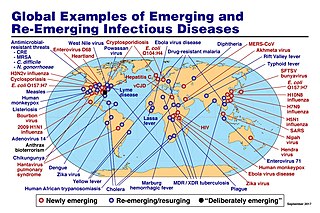Related Research Articles

A pandemic is an epidemic of an infectious disease that has spread across a large region, for instance multiple continents or worldwide, affecting a substantial number of individuals. Widespread endemic diseases with a stable number of infected individuals such as recurrences of seasonal influenza are generally excluded as they occur simultaneously in large regions of the globe rather than being spread worldwide.

The Joint United Nations Programme on HIV and AIDS is the main advocate for accelerated, comprehensive and coordinated global action on the HIV/AIDS pandemic.

Viral hemorrhagic fevers (VHFs) are a diverse group of animal and human illnesses. VHFs may be caused by five distinct families of RNA viruses: the families Filoviridae, Flaviviridae, Rhabdoviridae, and several member families of the Bunyavirales order such as Arenaviridae, and Hantaviridae. All types of VHF are characterized by fever and bleeding disorders and all can progress to high fever, shock and death in many cases. Some of the VHF agents cause relatively mild illnesses, such as the Scandinavian nephropathia epidemica, while others, such as Ebola virus, can cause severe, life-threatening disease.

Influenza A virus subtype H2N2 (A/H2N2) is a subtype of Influenza A virus. H2N2 has mutated into various strains including the "Asian flu" strain, H3N2, and various strains found in birds. It is also suspected of causing a human pandemic in 1889. The geographic spreading of the 1889 Russian flu has been studied and published.

An emerging infectious disease (EID) is an infectious disease whose incidence has increased recently, and could increase in the near future. The minority that are capable of developing efficient transmission between humans can become major public and global concerns as potential causes of epidemics or pandemics. Their many impacts can be economic and societal, as well as clinical. EIDs have been increasing steadily since at least 1940.
Antonios Antoniadis is a professor emeritus of the Medical School of the Aristotle University of Thessaloniki (Greece). For 14 years he was the director of the Α΄ Microbiology laboratory of the same School and Head of the “WHO Collaborating Centre for Reference and Research on Arbovirus and Hemorrhagic Fever Viruses” which he himself created in 1996.
The National Institute of Virology in Pune, India is an Indian virology research institute and part of the Indian Council of Medical Research (ICMR). It was previously known as 'Virus Research Centre' and was founded in collaboration with the Rockefeller Foundation. It has been designated as a WHO H5 reference laboratory for SE Asia region.

Awa Marie Coll-Seck is as Senegalese infectious diseases specialist and politician who served as Minister of Health of Senegal from 2001 to 2003 and again from 2012 to 2017. She also served as former Executive Director of the Roll Back Malaria Partnership and is on the board of directors of several notable global health organizations. She is an agenda contributor of the World Economic Forum.

Nathan Daniel Wolfe is an American virologist. He was the founder and director of Global Viral and the Lorry I. Lokey Visiting Professor in Human Biology at Stanford University.

A public health emergency of international concern is a formal declaration by the World Health Organization (WHO) of "an extraordinary event which is determined to constitute a public health risk to other States through the international spread of disease and to potentially require a coordinated international response", formulated when a situation arises that is "serious, sudden, unusual, or unexpected", which "carries implications for public health beyond the affected state's national border" and "may require immediate international action". Under the 2005 International Health Regulations (IHR), states have a legal duty to respond promptly to a PHEIC. The declaration is publicized by an IHR Emergency Committee (EC) of international experts, which was developed following the 2002–2004 SARS outbreak.

Disease X is a placeholder name that was adopted by the World Health Organization (WHO) in February 2018 on their shortlist of blueprint priority diseases to represent a hypothetical, unknown pathogen that could cause a future epidemic. The WHO adopted the placeholder name to ensure that their planning was sufficiently flexible to adapt to an unknown pathogen. Director of the US National Institute of Allergy and Infectious Diseases Anthony Fauci stated that the concept of Disease X would encourage WHO projects to focus their research efforts on entire classes of viruses, instead of just individual strains, thus improving WHO capability to respond to unforeseen strains. In 2020, experts, including some of the WHO's own expert advisors, speculated that COVID-19, caused by the SARS-CoV-2 virus strain, met the requirements to be the first Disease X.
Clade X: A Global Health Security Simulation was a pandemic modelling exercise led by Johns Hopkins University's Center for Health Security, which occurred on Tuesday, May 15, 2018 at the Mandarin Oriental Hotel in Washington, D.C. The exercise was named after a hypothetical novel virus, and simulated efforts to counter a fast-moving and deadly epidemic released on purpose by a terrorist group consisting of scientists and their rich backers wanting to reduce overpopulation. In the simulation, the hypothetical pandemic resulted in 900 million simulated deaths. The exercise was invitation-only and nearly 150 people attended.

Jean-Jacques Muyembe is a Congolese microbiologist. He is the general director of the Democratic Republic of the Congo Institut National pour la Recherche Biomedicale (INRB). He was part of team at the Yambuku Catholic Mission Hospital that investigated the first Ebola outbreak, and was part of the effort that discovered Ebola as a new disease, although his exact role is still subject to controversy. In 2016, he led the research that designed, along with other researchers at the INRB and the National Institute of Health Vaccine Research Center in the US, one of the most promising treatment for Ebola, mAb114. The treatment was successfully experimented during recent outbreaks in the DRC, on the express decision of the then DRC Minister of Health, Dr Oly Ilunga, despite a prior negative advice from the World Health Organization.

Michael Joseph Ryan is an Irish epidemiologist and former trauma surgeon, specialising in infectious disease and public health. He is executive director of the World Health Organization's Health Emergencies Programme, leading the team responsible for the international containment and treatment of COVID-19. Ryan has held leadership positions and has worked on various outbreak response teams in the field to eradicate the spread of diseases including bacillary dysentery, cholera, Crimean–Congo hemorrhagic fever, Ebola, Marburg virus disease, measles, meningitis, relapsing fever, Rift Valley fever, SARS, and Shigellosis.

Christian Heinrich Maria Drosten is a German virologist whose research focus is on novel viruses (emergent viruses). During the COVID-19 pandemic, Drosten came to national prominence as an expert on the implications and actions required to combat the illness in Germany.
Joseph Fair is a virologist and former vice president and director of research and development for Metabiota, Inc. Since March 2020 he has been a science contributor for the American television network NBC.
Nita Madhav is an epidemiologist and risk modeler who was CEO of Metabiota from 2019 - 2022.
Metabiota is a San Francisco startup that compiles data from around the world to predict disease outbreaks. The company is a partner with USAID's PREDICT and PREVENT programs. In the early months of the SARS-CoV-2 outbreak, Metabiota and BlueDot independently demonstrated the capabilities of computer analytics to map the future spread of the virus between countries.
References
- ↑ "Global Viral Organization". Archived from the original on 2022-05-09. Retrieved 2019-11-06.
- ↑ "Nathan Wolfe's website". Archived from the original on 2014-01-09. Retrieved 2013-12-07.
- 1 2 Walsh, Bryan (2011-10-28). "Virus Hunter: How One Scientist Is Preventing the Next Pandemic". Time. Archived from the original on 2022-10-02. Retrieved 2023-07-24.
- ↑ "A New Project to Track Animal Diseases Before They Infect Humans". Time. 8 February 2011.
- ↑ Langreth, Robert (15 October 2009). "Finding the Next Epidemic Before It Kills". Forbes.
- ↑ "Legacy Programs". 15 December 2019. Archived from the original on 6 November 2019. Retrieved 15 December 2019.
- ↑ Hope, Bradley (2015-05-20). "Virus Hunter Metabiota Finds Niche in Epidemic Research". Wall Street Journal . Archived from the original on 2021-12-23. Retrieved 2023-07-24.
- ↑ "About Global Viral". Global Viral. Archived from the original on 2012-10-13. Retrieved 2023-07-24.
{{cite web}}: CS1 maint: unfit URL (link) - ↑ "Sponsors". Global Viral. Archived from the original on 2012-10-14. Retrieved 2023-07-24.
{{cite web}}: CS1 maint: unfit URL (link) - ↑ "Partners". Global Viral Forecasting Institute. Archived from the original on 2011-02-04. Retrieved 2023-07-24.
- ↑ "Partners". Global Viral Forecasting Institute. Archived from the original on 2008-09-20. Retrieved 2023-07-24.
{{cite web}}: CS1 maint: unfit URL (link)